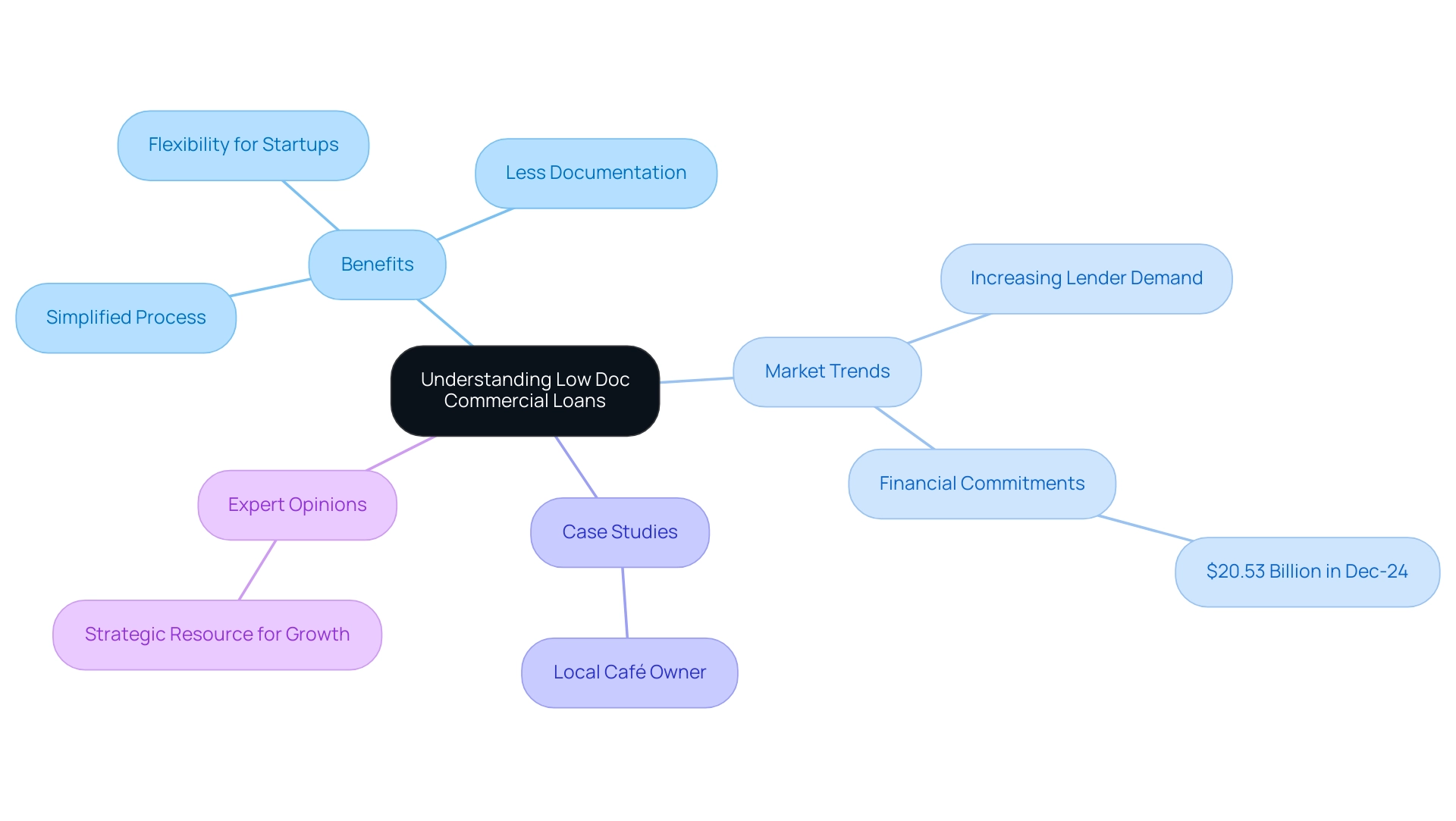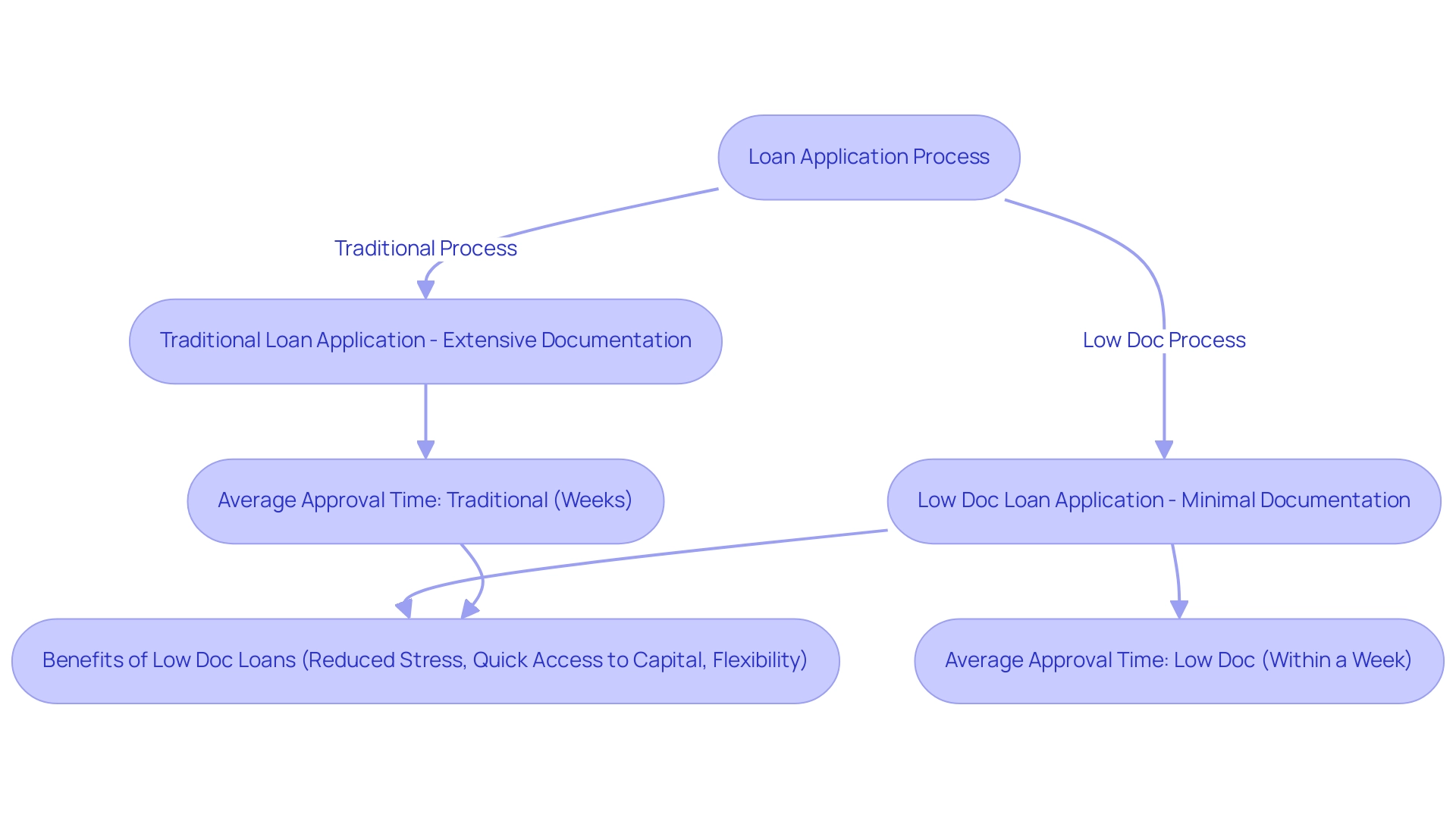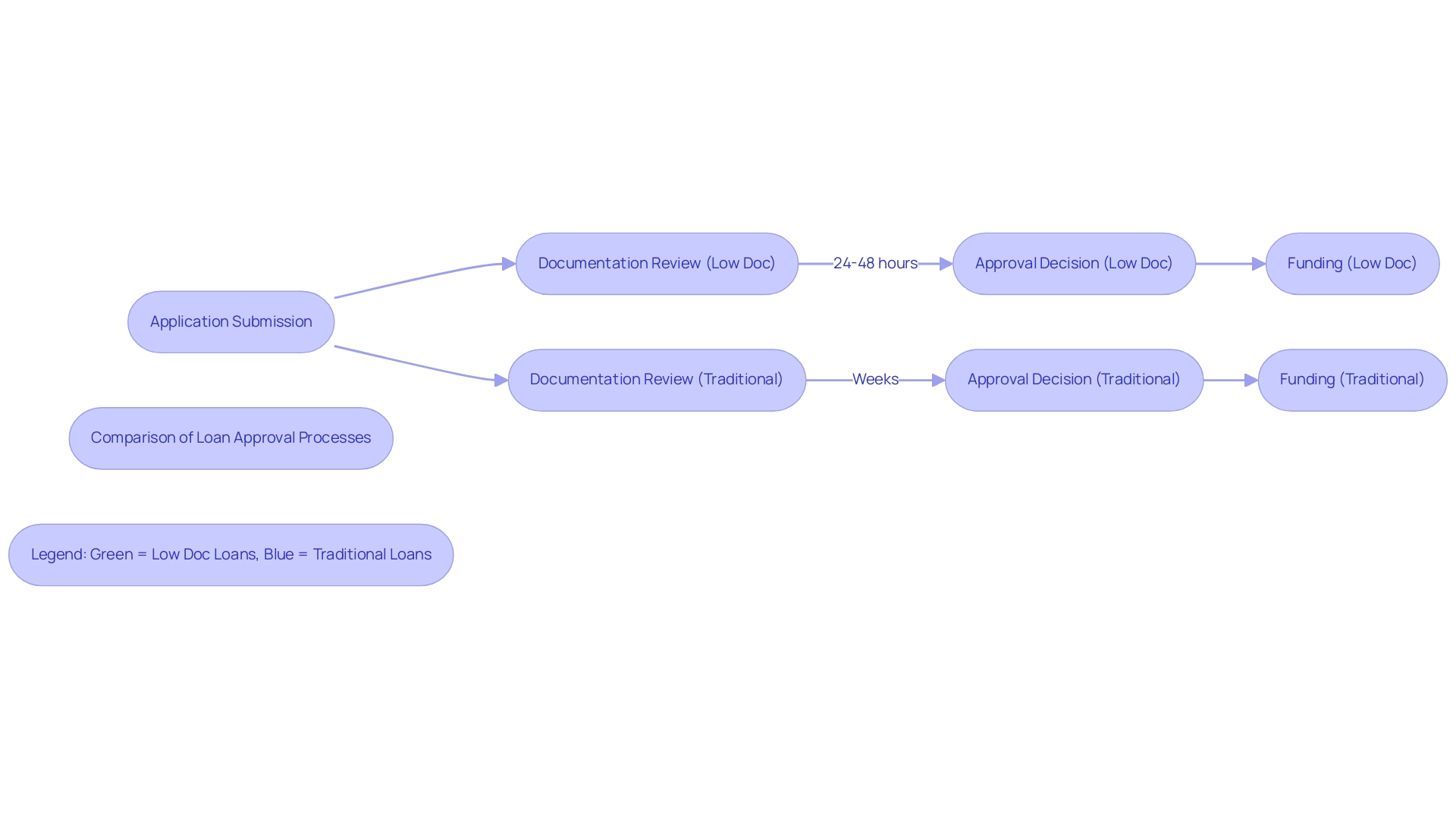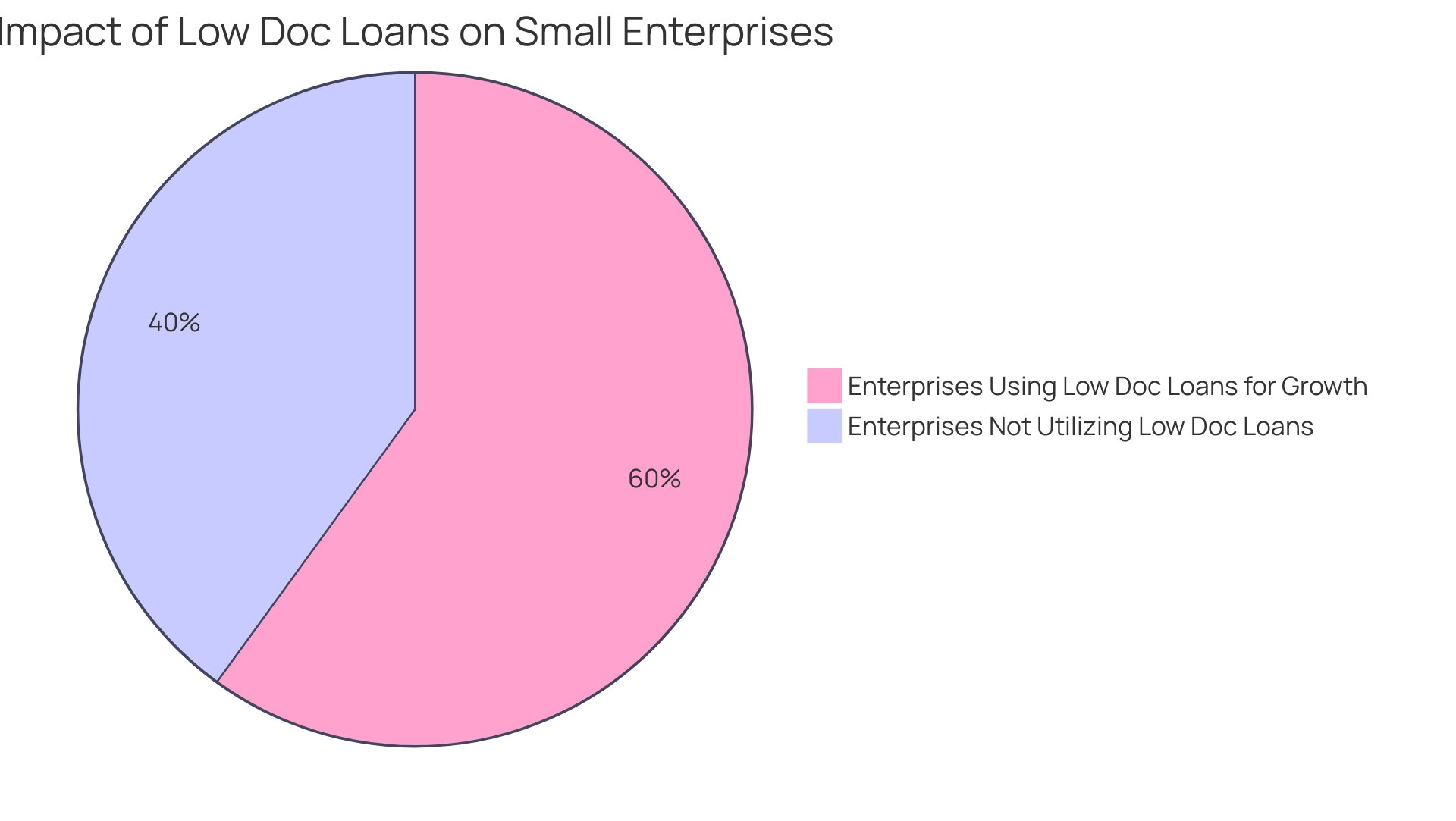Overview
Low doc commercial loans offer substantial advantages for small business owners, including:
- Streamlined documentation requirements
- Rapid access to capital
- Flexibility in income verification
These loans empower entrepreneurs to secure funding efficiently, often within days, without the burdensome paperwork typical of traditional loans. This efficiency not only facilitates business growth but also enhances operational agility in a competitive market. By minimizing the barriers to funding, low doc commercial loans represent a strategic solution for those looking to thrive in today's dynamic business environment.
Introduction
In a rapidly evolving financial landscape, small business owners are increasingly turning to low doc commercial loans as a strategic solution to meet their funding needs. These loans stand out by offering a streamlined application process that minimizes paperwork and accelerates access to capital. This makes them particularly appealing for entrepreneurs who may struggle with traditional lending requirements.
As the demand for flexible financing grows, the low doc loan market is witnessing significant trends. Lenders are recognizing the importance of accommodating diverse financial profiles. This article delves into the myriad benefits of low doc loans, showcasing how they empower businesses to thrive amidst challenges, improve cash flow management, and seize growth opportunities in a competitive market.
From quick approvals to innovative income verification methods, low doc loans are reshaping the way small businesses secure the funding necessary for success. Are you ready to explore how these loans can transform your business financing strategy?
Understanding Low Doc Commercial Loans: A Primer for Small Business Owners
Low doc commercial loans are specifically designed for borrowers who may struggle to meet the extensive documentation requirements of traditional financing options. These financial products are particularly advantageous for small business owners, as they simplify the funding process by minimizing documentation. This flexibility empowers entrepreneurs to secure the necessary funding without the burden of providing comprehensive financial statements, making low documentation options an appealing choice for those navigating the complexities of financing.
In 2025, the low documentation market is experiencing significant trends, with an increasing number of lenders acknowledging the demand for more accessible financing solutions. The value of new financial commitments for property purchases reached an impressive $20.53 billion in December 2024, underscoring the rising need for flexible lending options. Small business owners are increasingly turning to low doc commercial loans as a viable financing alternative, especially in a landscape where traditional lending criteria can be restrictive.
Case studies illustrate the effectiveness of low documentation financing in supporting small businesses. For instance, a local café owner successfully utilized a low documentation financing option to expand their operations, enabling them to acquire new equipment and hire additional staff without the lengthy approval process associated with conventional funding. This not only enhanced their service capacity but also contributed to increased revenue.
Finance Story's commitment to innovation and adaptability in the lending process allows it to present clients with tailored options, reinforcing the benefits of low doc financing.
The advantages of low documentation financing extend beyond ease of access. They provide small business owners the chance to leverage their existing assets and cash flow without the need for exhaustive financial disclosures. This is especially beneficial for startups and enterprises in growth stages, where rapid changes in financial status can complicate conventional credit applications.
Furthermore, Finance Story offers refinancing alternatives for commercial financing, enabling organizations to adjust their funding strategies as their needs evolve. This service is essential for entrepreneurs seeking to enhance their current financing and improve cash flow management.
Expert opinions emphasize the importance of low doc commercial loans in the current economic climate. Financial experts assert that these credits can serve as a strategic resource for small business owners aiming to capitalize on growth opportunities while maintaining operational flexibility. As the market continues to evolve, low doc commercial loans are poised to play a crucial role in assisting small enterprises throughout Australia in achieving their financial goals in 2025.
Finance Story understands the unique needs of each business, leveraging our comprehensive panel of lenders to craft robust business cases that cater to diverse lending needs, including various commercial properties such as warehouses, retail spaces, factories, and hospitality ventures.

Simplified Documentation: Streamlining the Loan Application Process
One of the standout advantages of low doc commercial loans is the significantly reduced paperwork required during the application process. Traditional financing options often demand extensive documentation, such as tax returns and detailed financial statements, which can be cumbersome and time-consuming for applicants. In contrast, low doc commercial loans streamline this financing process by typically requiring only a self-declaration of income along with minimal supporting documents.
This simplification not only accelerates the application experience but also alleviates the stress associated with gathering extensive paperwork.
For small business owners, who often juggle multiple responsibilities, low doc commercial loans provide a particularly advantageous reduction in documentation. In 2025, statistics indicate that low doc commercial loans can reduce the paperwork burden by up to 60% compared to traditional options, allowing for a more efficient and less daunting application process. Furthermore, the average time taken for low doc commercial loans approval is notably shorter, often completed within a week, compared to several weeks for traditional financing options.
Case studies demonstrate how small enterprises have successfully navigated the funding application landscape with minimal paperwork. For instance, a startup in Melbourne was able to secure funding swiftly through a low documentation option, enabling them to invest in essential equipment without the delays typically associated with traditional financing methods. This success story highlights the effectiveness of low doc commercial loans in facilitating quick access to capital.
Expert insights highlight the significance of streamlined financing processes for small business owners. As noted by Denise Raward, a Senior Finance Journalist, "One positive of low doc home financing is that they can still come with the usual home financing features, including: 100% offset accounts, redraw facilities, line of credit options, the ability to make extra and more frequent repayments, split and interest-only options." This quote underscores the flexibility and benefits that low doc loans can offer.
Additionally, Finance Story's specialized expertise in navigating challenging financial situations ensures that small enterprise owners have access to tailored mortgage brokerage solutions. As one pleased client, Natasha B from VIC, stated, "I will definitely be recommending your services to anyone. We are finished with the constant worry. Once again, thank you so much for being a part of our journey." Their extensive collection of lenders, including high street banks and creative private lending panels, positions them as a reliable resource for securing enterprise financing and refinancing choices designed to meet evolving organizational requirements. The benefits of streamlined documentation in low doc commercial loans provide a route for enterprises to obtain essential funding effectively, promoting growth and innovation in a competitive market.
Moreover, comprehending the regulatory landscape related to low doc commercial loans, including the function of Central Borrowing Authorities for EFS reporting, is crucial for small enterprise owners to effectively navigate their funding options. The refinancing choices accessible through Finance Story further improve the capacity to adjust to changing organizational needs.

Flexible Income Verification: Catering to Diverse Financial Profiles
Low doc commercial loans offer significant advantages for small enterprise owners, particularly those with non-traditional income sources. In 2025, around 30% of small enterprise owners reported relying on alternative income streams, underscoring the demand for flexible financing solutions. Unlike traditional financing, which typically necessitates standard documentation such as pay slips or tax returns, low doc commercial loans enable lenders to accept alternative forms of income verification.
This can include:
- Activity statements (BAS)
- Bank statements
- Profit and loss statements
These options facilitate access to financing for a broader range of borrowers.
At Finance Story, we excel in crafting polished, individualized financing proposals tailored to our clients' unique needs, ensuring they have the optimal chance of securing the right funding for their commercial property investments. We collaborate with a diverse array of lenders, from high street banks to innovative private lending panels, allowing us to provide customized solutions for various circumstances—whether you are acquiring a warehouse, retail space, factory, or hospitality venture. The flexibility in income verification not only streamlines the application process but also enhances the likelihood of approval for small enterprise owners.
For instance, a recent case study illustrated how a small construction firm successfully secured low doc commercial loans by submitting its BAS instead of conventional income documentation. This approach not only saved time but also enabled the business to access funds swiftly, allowing it to capitalize on growth opportunities.
Mortgage brokers play a pivotal role in this process, as they have access to a wider selection of low doc commercial loans and can assist clients in navigating the application procedure, ultimately improving their chances of approval. Expert opinions highlight the significance of these flexible verification options. Industry professionals note that low doc commercial loans cater to diverse financial profiles, accommodating those who may not conform to the traditional lending mold.
As the landscape of small enterprise financing evolves, the capacity to utilize alternative income verification methods is becoming increasingly crucial. Furthermore, Finance Story aids clients in navigating regulatory changes, ensuring they remain well-informed about the updated Code of Practice that has enhanced customer protections. This is particularly vital in the current financial environment, especially as rising interest rates since 2022 have rendered securitization less competitive compared to deposits.
Overall, low doc commercial loans are designed to meet the specific requirements of small enterprise owners, providing them with the financial assistance essential to thrive in a competitive market. As one satisfied client, Riya P., expressed, "Special thanks to Pranav this time for making our experience truly exceptional for our construction financing." This emphasizes Finance Story's commitment to client satisfaction and the effectiveness of low documentation options in facilitating business growth.
Quick Access to Capital: Fast Approval and Funding Processes
One of the most compelling advantages of low doc commercial loans is their expedited approval and funding process. Thanks to streamlined documentation requirements, lenders can often reach decisions much faster than they would with traditional credit applications. This swift turnaround is essential for small enterprise owners who may need prompt access to funds for various purposes, such as acquiring inventory, enhancing equipment, or seizing time-sensitive opportunities.
In 2025, the average approval duration for low doc commercial loans has significantly improved, with many lenders providing rapid approvals that can be finalized in as little as 24 to 48 hours. This efficiency allows enterprises to access capital swiftly, enabling them to act decisively in competitive markets. Statistics indicate that low documentation financing can provide funding at a speed that outpaces traditional options, which often involve longer processing times due to extensive documentation requirements.
For instance, while conventional credit options may take weeks to complete, low documentation financing can deliver funding in a fraction of that time, making them an appealing choice for small enterprises in need of prompt financial assistance. Additionally, case studies demonstrate that many small enterprises have effectively utilized low documentation financing to enhance their operations. A local retail store, for example, was able to secure funding within 48 hours to restock inventory during a peak sales period, showcasing how quick access to capital can directly impact performance.
Major financial institutions such as ANZ, Commonwealth Bank, NAB, and Westpac endorse this swift financing, offering competitive rates for simple commercial property investments.
As the landscape of small enterprise financing evolves in 2025, the trend toward rapid funding solutions persists, with low documentation options leading the way. Expert insights suggest that this approach not only meets the urgent financial needs of companies but also fosters a more agile and responsive financial environment, allowing entrepreneurs to thrive in an ever-changing marketplace. However, it is important to note that lenders may include an annual review as a 'get out clause,' allowing them to request additional cash to realign the value-to-value ratio if a valuation shows a reduction in value since the agreement was first established.
This emphasizes the necessity for small enterprise owners to thoughtfully evaluate the conditions of low documentation financing alongside their advantages.
At Finance Story, we focus on developing refined and highly personalized proposals that can assist you in obtaining the most suitable low doc financing tailored to your distinct situation. With access to a full suite of lenders, including high street banks and innovative private lending panels, we can help you maximize your financing options. To discuss your unique needs and goals, we invite you to schedule a free personalized consultation with Shane Duffy, Head of Funding Solutions at Finance Story.
Please select a time that suits you from our live calendar.

Improving Cash Flow Management: The Financial Lifeline for Small Businesses
Low doc commercial loans are increasingly recognized as vital financial resources for small enterprises facing cash flow difficulties. At Finance Story, we specialize in creating polished and highly individualized loan proposals that provide rapid access to funds. This allows owners to efficiently cover operational expenses, manage payroll, and seize growth opportunities without the lengthy approval processes typical of traditional financing. This swift infusion of capital can significantly enhance an enterprise's cash flow, contributing to greater financial stability and fostering long-term success.
In 2024, small enterprises in Australia surged by 7%, particularly in areas like New South Wales, Victoria, and Queensland. This growth underscores the need for flexible financing solutions that can adapt to the dynamic needs of these enterprises. Low doc commercial loans, with their simplified application procedures, cater specifically to this demand, enabling enterprises to respond quickly to financial pressures.
For instance, since the conclusion of the COVID-19 pandemic, commercial credit card spending has soared to an unprecedented $8.64 billion monthly, reflecting a shift in financial behavior among Australian enterprises. This trend signifies an increasing dependence on credit, which low documentation options can effectively complement by providing additional liquidity when necessary. Additionally, in 2022, $70 million was raised through 91 crowd-sourced equity funding deals, highlighting alternative financing options available to small enterprises.
Furthermore, financial consultants stress that low doc commercial loans can greatly enhance cash flow management for small enterprises. Shaun McGowan, founder of Money.com.au, states, "He's determined to assist individuals and organizations in paying as little as possible for financial products, through education and creating world-class technology." By alleviating immediate financial burdens, these loans empower owners to focus on strategic growth rather than being bogged down by cash flow issues.
As companies navigate the complexities of the current economic landscape, the ability to secure funding quickly becomes a crucial advantage.
Finance Story provides a comprehensive selection of lenders, including high street banks and innovative private lending panels, ensuring that small enterprises have access to the best financing options available. Furthermore, we can help with restructuring commercial financing to cater to the changing demands of your enterprise. Small enterprise owners can also explore cash flow solutions offered by CommBank, such as Stream Working Capital and Overdraft, which provide additional support in managing their finances effectively.
In summary, low doc commercial loans not only support operational continuity but also improve overall financial health, making them a crucial resource for small enterprises aiming to thrive in today's competitive environment. With Finance Story's expertise in customized financing solutions, including term lending, debtor finance, asset finance, and more, you can secure the right funding to advance your venture.
Fueling Business Growth: Leveraging Low Doc Loans for Expansion
Low doc commercial loans are an essential resource for small enterprise owners aiming to drive growth and seize expansion opportunities. These financial aids provide critical capital that can be directed towards various initiatives—acquiring new equipment, hiring additional staff, or launching impactful marketing campaigns. Data from 2025 indicates that small enterprises utilizing low documentation financing have experienced substantial growth, with many reporting increased revenue and market share as a direct result of their investments.
For instance, a recent analysis revealed that approximately 20% of recent insolvencies involve small enterprises undergoing restructuring. Many of these businesses are leveraging low doc commercial loans to support their recovery and expansion efforts. This trend underscores the potential of low doc commercial loans to not only address urgent financial needs but also to foster long-term commercial resilience and growth. Furthermore, Finance Story's expertise in crafting customized funding proposals—tailored for various commercial properties such as warehouses, retail spaces, factories, and hospitality projects—ensures that small enterprise owners navigate the complexities of financing with confidence.
Low doc commercial loans can be particularly advantageous for enterprises facing economic challenges. With depleted cash reserves and increased revenue sensitivity, these financial products offer a pathway to secure necessary funding without the extensive documentation typically required by traditional lenders. Consequently, small enterprise owners can swiftly obtain the funds needed to implement their growth strategies.
Investing in expansion efforts through low doc commercial loans has yielded encouraging outcomes in 2025, with numerous companies reporting positive results. By embracing these financing options, small enterprise owners can enhance their competitiveness in the market, positioning themselves for sustained success and growth in an ever-evolving economic landscape. Numerous examples exist of small enterprises that have effectively leveraged low doc commercial loans to expand their operations, illustrating the transformative impact of these financial solutions on their growth trajectories.
Moreover, McKinsey notes that embedded lending is already associated with higher profit margins, further strengthening the case for low doc commercial loans as a strategic funding choice. It is crucial to acknowledge the significant gap in the adoption of embedded services, with 83% of consumer lenders offering them compared to only 45% of SMB lenders. This disparity highlights the current market landscape for small enterprises seeking financing. Additionally, restructuring existing debts can provide more flexibility for enterprises aiming to adapt to changing market conditions.
With Finance Story’s extensive array of financing solutions, including customized options for enterprise finance and commercial property funding, small enterprise owners have access to the resources they need to meet their specific requirements.

Gaining a Competitive Edge: How Low Doc Loans Can Benefit Your Business
In today’s challenging market, securing a competitive advantage is essential for small enterprises. Finance Story's low doc commercial loans provide a significant edge by enabling quicker access to capital, allowing businesses to respond promptly to market fluctuations and emerging opportunities. As one of Australia’s most innovative mortgage brokerages, Finance Story specializes in tailored financial solutions, ensuring that small enterprise owners can enhance their operational agility, invest in growth initiatives, and ultimately strengthen their market position.
For instance, a 2020 survey revealed that:
- 56% of companies sought financing primarily to cover operating expenses
- Others aimed to expand or acquire assets
This highlights the diverse funding needs of enterprises and underscores the importance of flexible financing options, such as low doc commercial loans, that Finance Story expertly facilitates. As one pleased client, Natasha B. from VIC, stated, "I will definitely be recommending your services to anyone."
We are finished with the constant worry. Once again, thank you so much for being a part of our journey. With access to a comprehensive panel of boutique lenders, private investors, and mainstream banks, Finance Story can curate tailored solutions to navigate financial challenges effectively, ensuring organizations remain responsive to market demands.
Furthermore, low doc commercial loans can significantly influence an enterprise's ability to adapt and thrive in a competitive environment. In 2025, small enterprises taking advantage of low doc commercial loans are better positioned to seize opportunities, as they can quickly mobilize resources without the lengthy paperwork typically needed for conventional financing. This agility not only enhances their operational capabilities but also allows them to maintain a competitive edge in an ever-evolving market.
As the Transportation & Logistics sector continues to experience fluctuations in EBITDA multiples, with companies in the $1-3M EBITDA range having multiples between 4.7x to 11.5x, small enterprises can utilize low doc commercial loans to capitalize on these changes, ensuring they remain agile and responsive. Furthermore, small enterprises have generated 17.3 million net jobs in the past 26 years, with 63% of new positions originating from small enterprises, highlighting their essential role in the economy and the need for adaptable financing options.
Additionally, Finance Story offers construction finance options available up to $5M, providing further context on financing alternatives for small enterprises. By integrating low doc commercial loans into their financial strategies, small business owners can effectively navigate the complexities of the market, positioning themselves for sustained growth and success.
Conclusion
Low doc commercial loans are transforming financing for small businesses by providing a streamlined application process that minimizes paperwork and accelerates access to capital. These loans are particularly advantageous for entrepreneurs navigating the complexities of traditional lending requirements, establishing themselves as a crucial resource in today’s economic environment.
The benefits of low doc loans extend beyond mere convenience; they empower business owners to leverage existing assets and alternative income sources, facilitating funding without the burden of extensive documentation. With swift approvals and adaptable income verification, businesses can swiftly respond to market opportunities and challenges, a necessity in a rapidly evolving economy.
Moreover, low doc loans enhance cash flow management and bolster growth initiatives. By ensuring immediate access to capital, these loans enable small businesses to manage operational costs, invest in expansion, and maintain competitiveness.
In conclusion, low doc commercial loans are indispensable for small business owners striving to excel in a competitive landscape. By harnessing these flexible financing solutions, entrepreneurs can elevate their operational capabilities and secure a fortified position in the marketplace. As the demand for accessible financing continues to rise, low doc loans will increasingly serve as a vital component in the success of small businesses across Australia and beyond.




